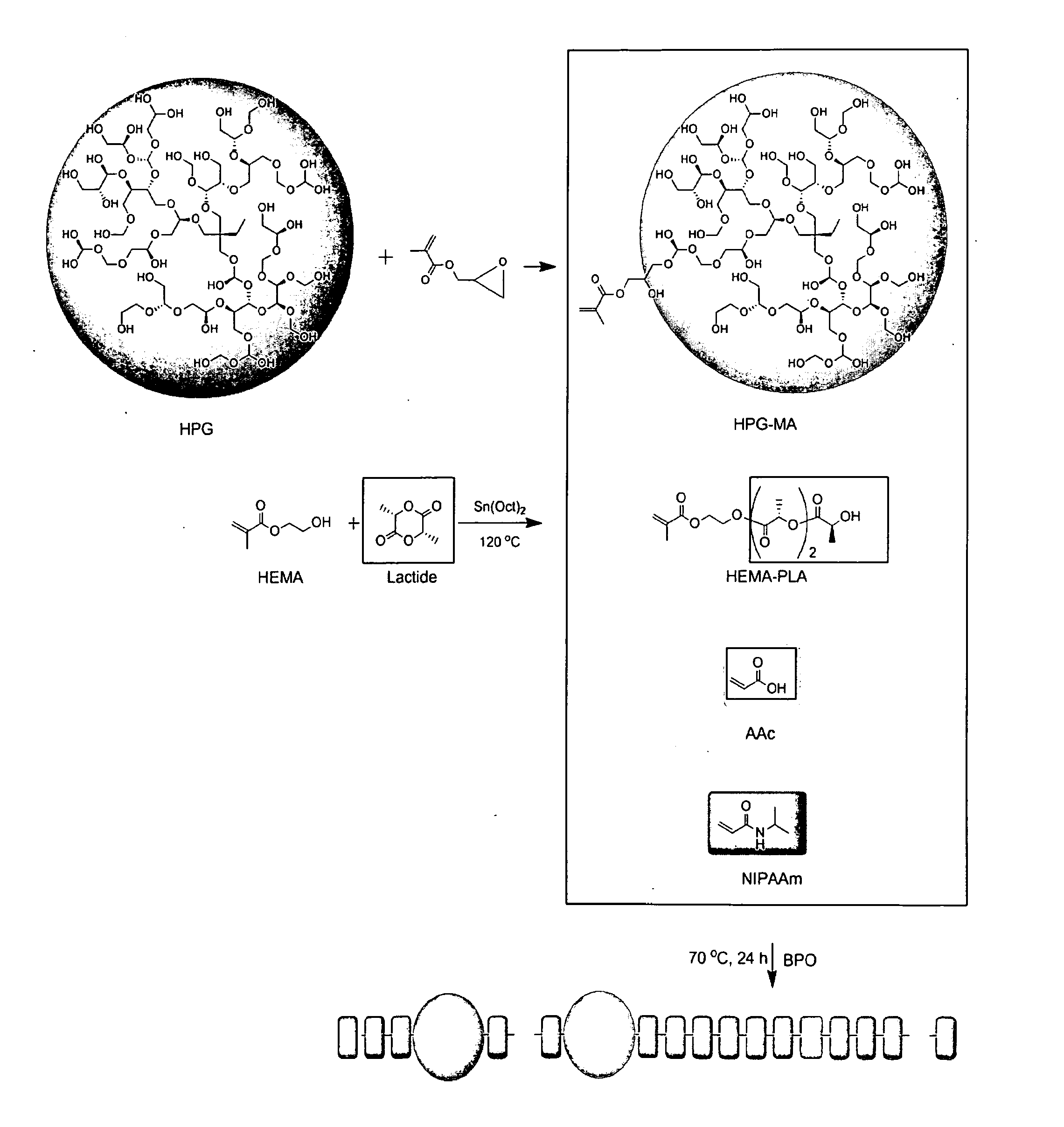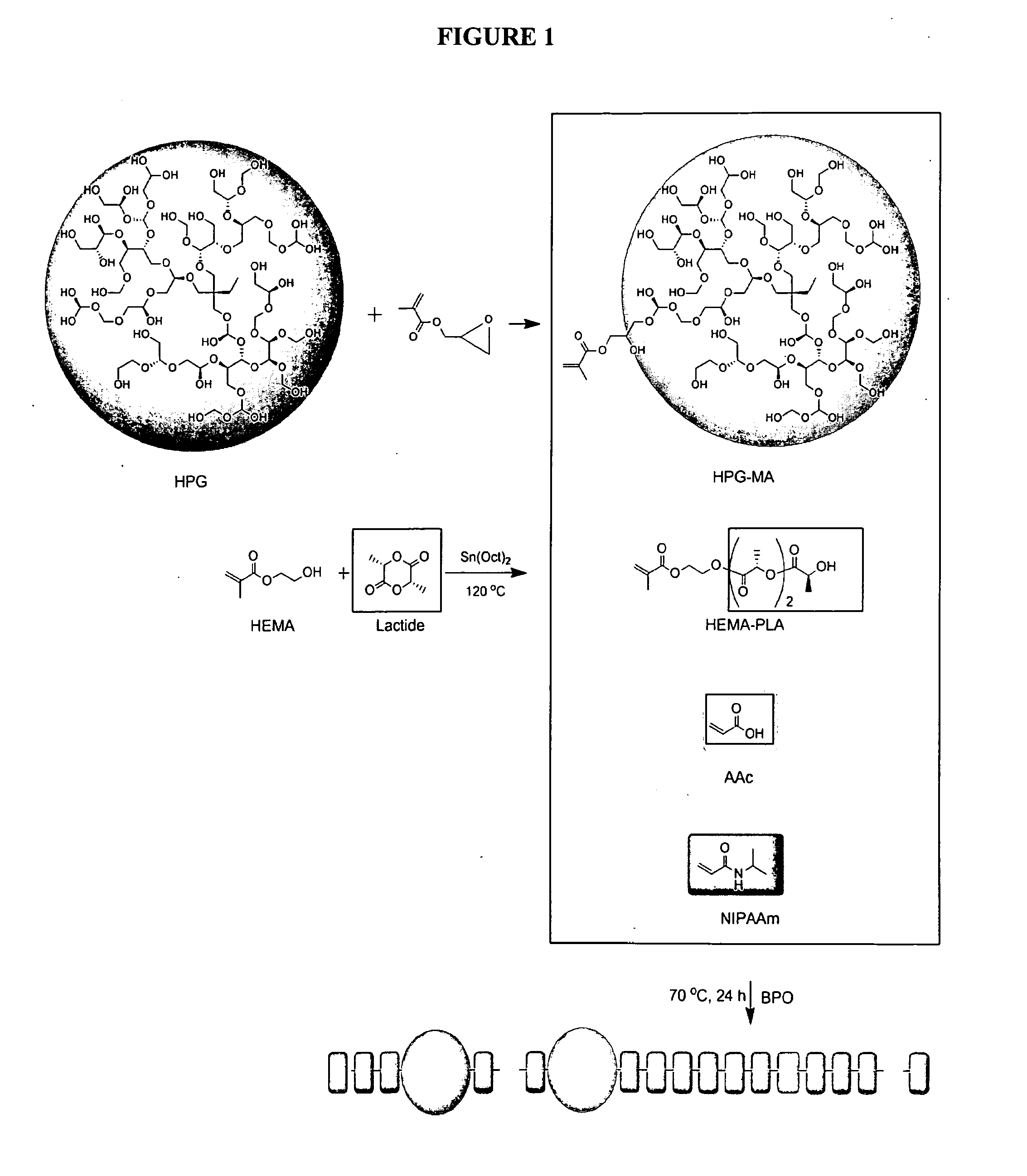Biodegradable liquogel and ph sensitive nanocarriers
a liquogel and nanocarrier technology, applied in the field of temperature responsive liquogel and ph sensitive nanocarriers, can solve the problems of biological non-degradability, deleterious effects in patients, and systemic therapy does not necessarily provide therapeutic tissue level of a drug
- Summary
- Abstract
- Description
- Claims
- Application Information
AI Technical Summary
Benefits of technology
Problems solved by technology
Method used
Image
Examples
example 1
[0117]HPG (Mn,MALDI=1096 g mol−1, Mw / Mn=1.13) was prepared according to the literature by controlled anionic polymerization of glycidol [21], The average number of terminal hydroxyl groups per HPG molecule was approximately 29 as determined by the relative integrals from the inverse gated 13C NMR spectra. (FIG. 21) Glycidyl methacrylate (GMA), Acrylic acid (AAc), and N-isopropylacrylamide (NIPAAm) were purchased from Sigma-Aldrich (St. Louis, Mo.). AAc was purified immediately prior to use by passage through a basic alumina column. NIPAAm was recrystallized from hexane and vacuum dried. Benzoyl peroxide (BPO), stannous 2-ethylhexanoate [(Sn(Oct)2],(3S)-cis-3,6 Dimethyl-1,4-dioxane,-2,5 dione (98%) (L-lactide), 4-(N,N-diethylamino)pyridine (DMAP), anhydrous dimethyl sulfoxide (DMSO), anhydrous 1,4-dioxane, methyl sulfoxide-d6 (99.9% atom D), anhydrous methanol, tetrahydrofuran (THF), and phosphate-buffered saline (PBS) were purchased from Fisher Scientific (Pittsburgh, Pa.). All poly...
example 2
[0134]The thermoresponsive nature of a liquogel according to the invention in 16.5 wt % phosphate buffered saline (PBS) solution was investigated to determine the lower critical solubility temperature (LCST) at which gelling begins to occur. The solution that is clear at 10° C. progresses to cloudy at 24° C. to a solid gel at 35° C. These results are shown in Table 2 and FIG. 18.
TABLE 2Qualitative observation of the liquogel gelation temperatureTemperature (° C.)Visual Appearance0Clear24Cloudy28Solid firming30More liquid + solid35Gels
[0135]The LCST was also investigated by measurement of the liquogel solution optical absorption as a function of temperature using UV / Vis spectroscopy and differential scanning calorimetry differential scanning calorimetry (DSC). Scanning the liquogel solution at 500 nm over the temperature range of 0° C. to 43.3° C. (see FIG. 19), the temperature at which the optical absorption rapidly transitions (the LCST) occurs around 35° C. This was also confirmed...
example 4
[0138]The cytotoxic effects of a pH triggered delivery system of fulvestrant, camptothecin or nanocarrier on MCF-7 cells is shown in FIGS. 16 and 17. Comparison of cytotoxic effects by Fulvestrant, Camptothecin and Nanocarrier.
PUM
| Property | Measurement | Unit |
|---|---|---|
| weight % | aaaaa | aaaaa |
| temperatures | aaaaa | aaaaa |
| temperature | aaaaa | aaaaa |
Abstract
Description
Claims
Application Information
 Login to View More
Login to View More - R&D
- Intellectual Property
- Life Sciences
- Materials
- Tech Scout
- Unparalleled Data Quality
- Higher Quality Content
- 60% Fewer Hallucinations
Browse by: Latest US Patents, China's latest patents, Technical Efficacy Thesaurus, Application Domain, Technology Topic, Popular Technical Reports.
© 2025 PatSnap. All rights reserved.Legal|Privacy policy|Modern Slavery Act Transparency Statement|Sitemap|About US| Contact US: help@patsnap.com



